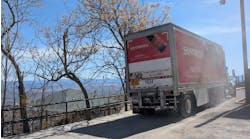If there’s one thing any commercial truck owner wants to know about the current Phase I and soon-to-go-live Phase II stage of fuel efficiency rules aimed at reducing greenhouse gas (GHG) emissions, it’s how much they’re going to cost.
And while those rules, crafted jointly by the EPA and National Highway Traffic Safety Administration (NHTSA), are touted for their long-term fuel savings and cost-reduction capabilities, it’s the short-term sticker price impact that’s got most fleets concerned.
Avron Mitchum, EPA program manager, stressed that the Phase I fuel efficiency effort is returning money to the pockets of truckers and to the U.S. economy as a whole.
Mitchum noted that EPA estimates the average cost for a single tractor-trailer to comply with the Phase I rules ranges between $5,000 and $6,000, yet results in annual fuel savings that range from $1,500 to $3,750 based on type of application.
For Phase II, he said EPA and NHTSA will look at tractor-trailers as a “system.” Unfortunately, from the trucking community’s perspective, no one is really sure at the moment what the overall cost impact of that might be.
DEVELOPING NEW APPROACHES
To meet the Phase II rules, new tactics could include engine cylinder deactivation, which will improve efficiency by disabling or deactivating about half of the cylinders when the load is less than half of the engine’s total torque capability; new camshaft phasing control, which optimizes size vs. torque for dynamic stability; and speed limiters to control fuel economy.
Further improvements include aerodynamics (roof and fuel tank fairings, cab design and lower side skirts) and enhancements such as low-rolling resistance tires and overall weight reduction of trucks and trailers, noted Jim Sweeney, vice president of capital equipment for AmeriQuest Transportation Services.
“Although the 2014-2018 standards are adding a projected $6,200 to the price of new trucks, according to EPA and NHTSA, the estimated lifetime fuel savings for heavy-duty trucks made in model years 2014-2018 are projected to be $79,089, with the added cost recouped in less than one year,” he noted.
Similar returns are expected from Phase II compliance, especially where trailers are concerned.
For example, the trailer aerodynamic device mandates put in place by the California Air Resources Board (CARB) back in January 2013 specified that all 53-ft. dry van and refrigerated trailers operating within the borders of the Golden State must be equipped with EPA SmartWay-approved fuel-saving aerodynamic devices.
“The cost of trailer aerodynamic devices averaged about $2,500 per trailer in 2008, requiring about a 30-month ROI payback period for a fleet averaging 105,000 mi. annually with a tractor-to-trailer ratio of 2.5 to 1,” Stephan Lemieux, manager of the on-road heavy-duty diesel section of CARB, said. “By 2012 that cost dropped to $1,250 per trailer with the payback period falling to 11 months and by 2013 reached $1,000 per trailer with an ROI of under 11 months.”
The development of a new proposed category 11, or PC-11, is another change being driven by Phase II rules affecting engine oil formulations.
And there will be a cost to that switch, explained Jim Gambill, Chevron’s North America Commercial and Industrial brands manager, though one that will be mitigated by a fuel savings. He noted that the price differential between thinner 10W-30 and thicker 15W-40 blends is not large, but the lower viscosity formula is able to deliver about a 1% to 2% fuel economy savings.
“When we isolate the engine oil performance in the lab, we see savings of about up to 1%, but even a half percent gain in fuel economy can save significant money over time when diesel is costing near the $4/gal. mark,” Gambill explained. “We’re [also] seeing reduced use of diesel exhaust fluid and longer oil filter life as well, so there are ‘ripple effect’ savings to be gained by switching to lower viscosity engine oils.”


